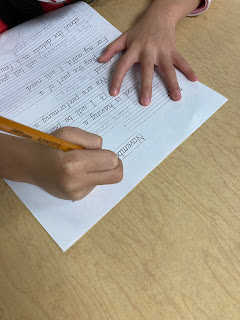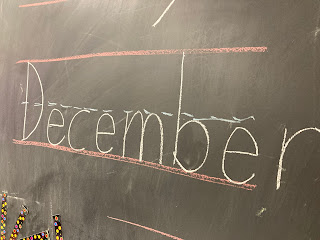Note: This image was created using Dall-E with the prompt "A child riding an oversized pencil in the style of surreal, digital art" on December 2, 2023. I know Andrea Sykes showed us how to do proper citation for AI generated texts, but I'll get better at it in 2024, I promise.
D2.2 - this is the expectation code that caused the most commotion when the updated Ontario Language curriculum was released in June. For Grade 2s, it says:
print legibly and fluently, with appropriate formation patterns, size, placement, and spacing
For the Grade 4s, this same expectation says:
write in cursive, forming letters of appropriate shape, size, proportion, and slant to improve the legibility of texts, and begin to develop fluent keyboarding skills using touch-typing techniques
How do you fit in this type of instruction, along with all the other requirements of the curriculum? Last week, I decided to conduct a "one-off" lesson on printing and handwriting techniques in conjunction with my drama focus. We are preparing for the big concert in December and I wanted to communicate with the families about what outfits the students would need for the show. To "kill two birds with one stone", I elected to create a fill-in-the-blank letter that would allow students to practice printing or writing while paying attention to all those criteria listed in the new expectation.
A very long time ago, I purchased a CD-ROM (!) that provided several kinds of printing and handwriting fonts with lined backgrounds. This made generating my letter template easy.
I drew the equivalent lines on the board and did some direct, explicit teaching on how to form letters.
I took photos of every student as they wrote their letters. One reason was to note their pencil grip. Another reason was to capture evidence of their printing or handwriting results. The third reason was to eventually add some of these photos to their BrightSpace portfolios, with a short audio reflection by them on their thoughts about learning to write in cursive or print.
I know that there are certain printing methods or techniques. I did not religiously follow any of those. I reviewed "ground", "grass" and "sky" letters so students would know where on the lines to place the letters.
The challenging part about this "one-off" lesson, especially for the students learning cursive, was that there wasn't a lot of opportunity to practice certain new letter shapes over and over. Capital letters in particular are extra-hard, because there are a lot of loops and curves (and the formation depends on what method you adopt - I found this article on
cursive writing styles and this overview article with
visuals of how the types differ). I know my own handwritten capital letter F doesn't look like the "traditional" capital letter F. Is my way "wrong"? Or just different? When do we move from saying a letter formation is different to being wrong?

I have to give huge credit to the Grade 3 teachers in my school. Both of them have conducted specific lessons with their students teaching them how to form letters. Honestly, I pushed the students a bit too hard and fast with this task. I asked them to sign their names at the bottom of their letters in cursive and many of them explained that they didn't know how because they hadn't covered those letters yet in their homeroom class instruction! Not quite fair, was it? I modelled a lot of signatures on the board and they all gamely tried to mimic.

To try and comfort my students, I told them the true story of when I was in Grade 5 or 6. Back then, you weren't allowed to write using a pen unless your handwriting was deemed "up to snuff". You had to use a pencil until you were "good enough". Despite the fact that I have excellent penmanship now, it took me all the way up until the third term before I was permitted to use a pen to do my school work. One of the students asked a brilliant question in response: "So what if the teacher had bad handwriting? Did that mean the principal took away their pens?" I've heard of older teachers remembering their time in teacher's college being scolded or reprimanded by their host teachers for not having model handwriting skills. Neat printing, along with playing the piano, used to be two requirements for kindergarten or early primary teachers. How times have changed!

I still have a few weeks left in my Media Part 2 Additional Qualification course, and I promised that I would reflect on the media literacy implications from this lesson.
- Key Concept #3 is that audiences negotiate meaning. Who determines what the "best" way is to form a capital letter F? How many people need to be able to decipher someone's handwriting for it to be considered "legible"?
- Key Concept #4 is about economic implications. How many cursive writing primers have educators purchased (or illegally downloaded) in order to teach their students how to "do" handwriting?
- Key Concept #5 centers on value messages. What does neat handwriting "say" about a person? Did this value judgement get lost when educators stopped teaching handwriting? Will this connection between student and print quality return? Why do students have to learn about printing and writing in cursive when keyboarding skills are also required starting in Grade 4? Which skill set (typing using touch-typing methods or printing) is more important?
- Key Concept #6 focuses on political and social messages. What cultures or languages might have an advantage when learning to print or write in English? How does the technology of ink influence the attention to handwriting? How does it connect to calligraphy? When do we switch from all being able to print the same to the evolution of our own individual, unique signature? How important is it nowadays to have your own signature? What occupations are known for their terrible handwriting vs excellent handwriting, and why? When will the Ontario Ministry of Education finally release the examples for teaching these various expectations, including D2.2?
- Key Concept #8 looks at aesthetics. What is it about cursive writing that appeals to some. How does a nicely printed letter compare to a well handwritten letter?
I hope that this authentic use of handwriting and printing was useful. (I learned that only 1/3 of the Grade 1 classes have explicit printing lessons, at least based on what the students shared.) I'll try and sprinkle in more opportunities to practice so that the classroom teachers aren't overwhelmed with all the responsibility of instructing.

































